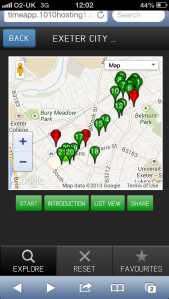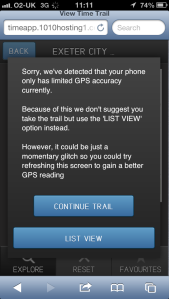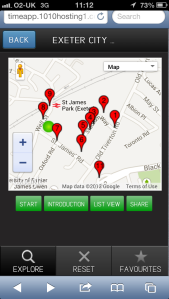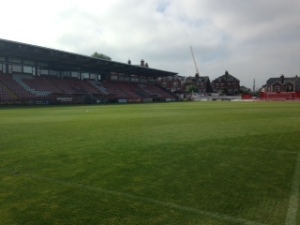I have spent some time over the last few days testing and re-testing the Exeter City FC trail. The first time I tested it, some locations were not picked up and GPS accuracy was an issue, but after more development by Andy, I finally managed to complete the trail this morning, successfully visiting all 23 locations, despite poor connectivity (you can see that from the fact the dot is orange rather than green). The next step is to see what the volunteers recruited by Exeter City FC Supporters Trust will make of it on 21 September. We would really welcome some feedback at this stage by fans who are not familiar with the project.
I mentioned before that we will be able to test the trail (or the idea of telling a history through a trail) as part of Jamie Vittle’s Kick Start programme. As we will be able to use the inside of St James Park for this, we decided to build a new, shorter trail, that would again tell the history of the club and trust through a set of locations inside the Park. So, in this case, we will need to identify the relationship between these locations and individuals, and then use both to build up the history of the club and trust.
The first noticeable thing is that there is poor connectivity inside the Park (you can again see that from the orange dot). This may mean that we will not be able to rely solely on technology, and, typically for mixed reality environments (i.e. environments using both physical and digital locations), we will need to turn the possibility of error, and related ambiguity, to our advantage.
However, there are also parts of St James Park which have a very good signal. Being inside the Park opened up all sorts of new possibilities of wayfaring which I will discuss in more detail in my next blog. But even just by looking at the image, you can see that the area in contained, the spaces charged with meaning, the atmosphere, even on a grey day, quite vibrant and evocative.
In the meantime, though, a few more words on the significance of trails. Anthropologist Tim Ingold in his fascinating book called Lines reminds us of the difference between trail-following, or wayfaring, and pre-planned navigation. The wayfarer follows a path that has been previously travelled, stepping into the footsteps of others. The navigator uses a map, a representation of a territory, upon which they can plot their travel (2007: 15-16). Ingold points out that readers of the Middle Ages were wayfarers, following sign posts that enabled them to ‘find their way within the landscapes of memory’ (2007: 16). Remembering then, Ingold notes, becomes a performance: ‘the text is remembered by reading it, the story by telling it, the journey by making it.’ (2007: 16). In my forthcoming book, which I am writing these days, I am hoping to show how digital archives can be used in distributed physical spaces to prompt communities of users towards remembering facts that could be used to generate valuable knowledge. I hope, by exploring texts and images from Exeter City FC’s archive, or RAMM’s archive in the broader project, whilst travelling, or wayfaring, to facilitate the ‘performance’ of memory and prompt stories that would, brought together, generate a given community’s ‘living’ history.
References
Giannachi, G. (2015, forthcoming) Archive Everything (Cambridge, Mass.: MIT Press).
Ingold, T. Lines (2007) A Brief History (London and New York: Routledge).







